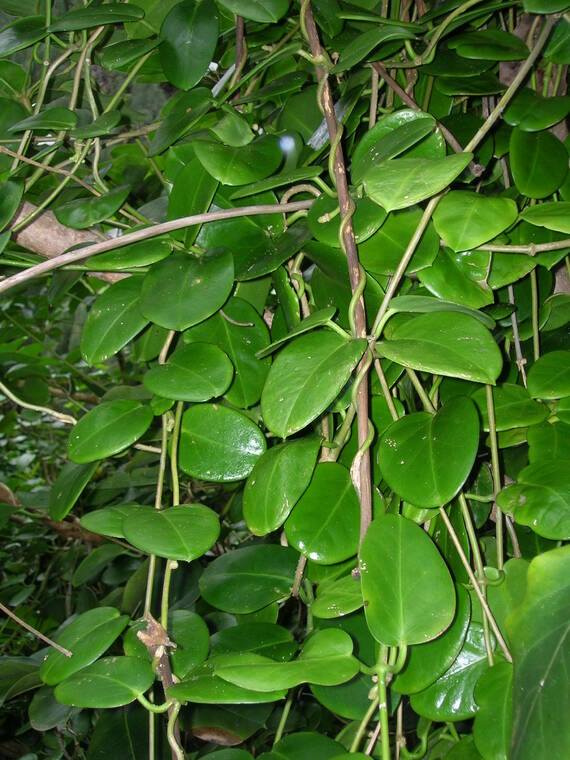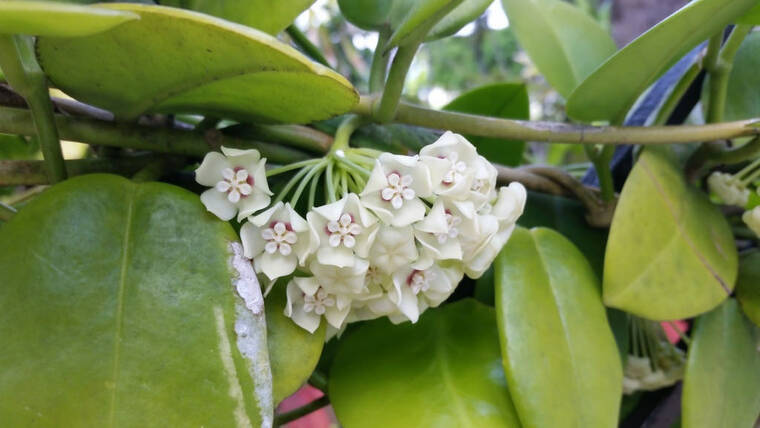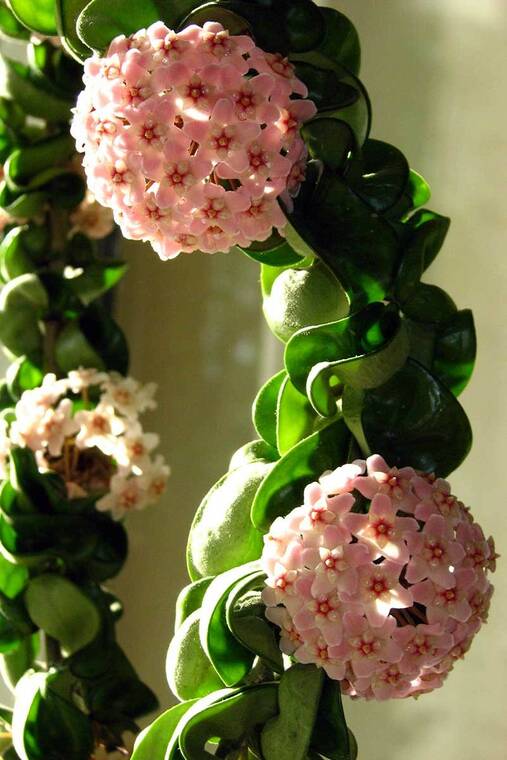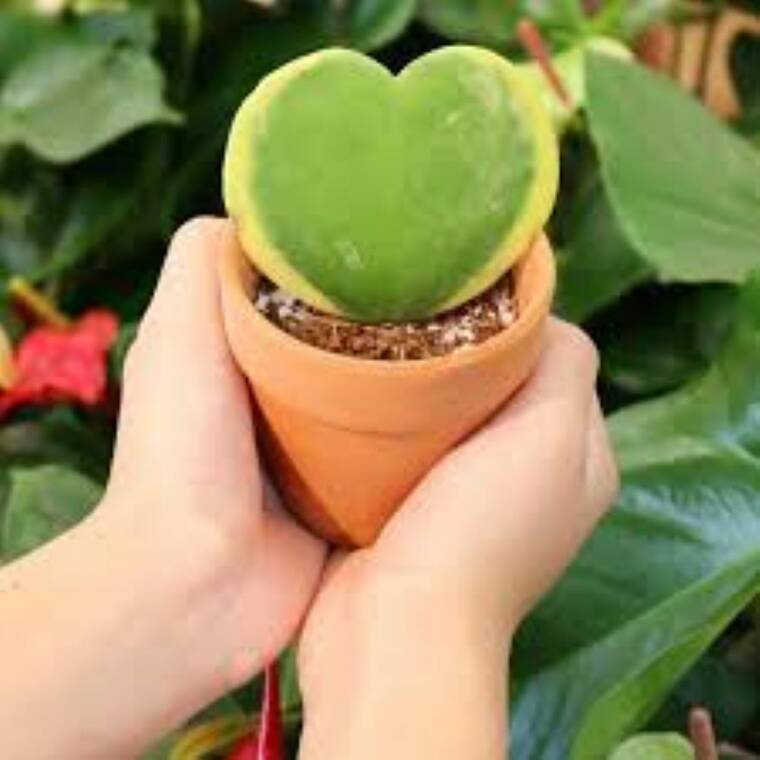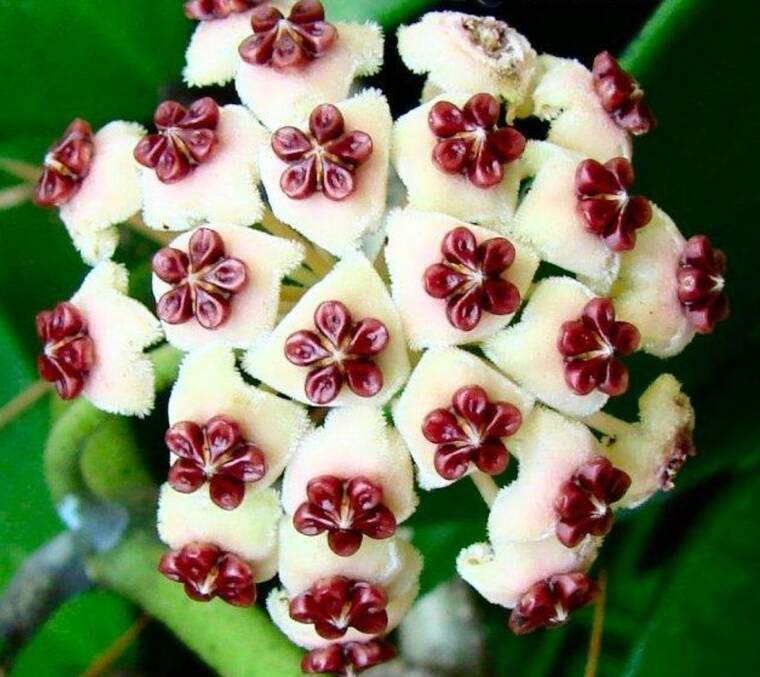Plant of the Month for May 2023 – Hoya
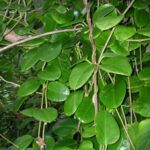
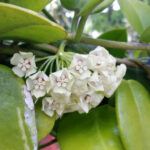
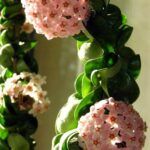
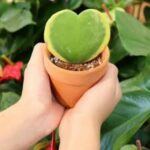
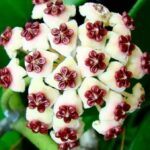
Hoya is a plant that exists slightly under the radar. Its beauty is a bit understated. Most plants in the Hoya genus are slow growing epiphytic succulents with lovely small, waxy flowers that grow in clusters and are delicately fragrant. Devoted hoya lovers are often rare-plant enthusiasts who take pride in their plants and may collect many varieties. The rest of us, find the plant attractive and interesting and may want to include a few in our garden or in our homes.
All hoyas are in the Asclepiadaceae or Milkweed Family. Several better-known plants with fragrant flowers,including stephanotis and pakalana, are also in this family. The Hoya genus has several hundred species that are either sprawling shrubs, twining vines or climbers. Several species are cultivated in Hawaiian gardens and are available locally.
Hoya carnosa is perhaps the most popular variety. This plant is native to southern China and Hong Kong and is
often grown as a houseplant throughout the world. Sometimes known as wax flower, this hoya is known as pua hoku in Hawaiian. The plant is a climber and
grows best with a trellis or supportive structure to climb on. Her tiny flowers appear in clusters of thirty or more, have a light fragrance and are usually white or a fleshy pink color. Her thick, succulent leaves can be dark green or variegated and the stems, like most hoyas, contain a milky sap.
An interesting cultivar H.carnosa ‘compacta’ is known as Hindu rope plant. It has overlapping, distorted
shaped leaves and grows without support in ropes that can be sprawling on the ground or cascading from a
hanging container. Despite the different growth habit, the ‘compacta’ flowers are nearly the same as those of
the H.carnosa.
Hoya australis is a slightly different variety that is native to Australia and the islands of Oceania. It was
introduced to Hawaii around 1860 and is sometimes used in haku lei. It has a more shrub-like growth habit and
does not need support. The similarly fragrant flowers grow in a loose cluster and tend to be cream colored with darker colors under the corona.
Hoya Kerrii, is native to tropical parts of southeast Asia and is commonly known as the sweetheart plant. This species is named for its large, heart-shaped leaves that are quite thick. Its inflorescence is similar in appearance and fragrance to other hoya but with a somewhat darker corona. This species is a bit harder to find but an Oahu nursery Mari’s Urban Garden appears to carry them. Check the website https://maris-urbangarden.com or call (808) 888-0819 to see if they can send interisland.
Several other hoya can be found here but these four are the most readily available in local nurseries. In the
wild, these epiphytic plants grow in the crevices of trees rather than in soil. Even in cultivation, they do not require rich soil to thrive. They do best in loose soil or chunky potting mixes like orchid bark that allow plenty of air flow to the roots.
Hoyas are fairly drought tolerant and are prone to root rot if kept in wet soil. They do best in partial shade
locations and can go for more than a week between waterings. The top of the soil should be dry before you
consider watering them.
Despite their drought tolerance, hoyas prefer humid growing conditions. Spraying them lightly between
waterings or growing them in groups can help increase the humidity.
Though seeds are available online and some success is possible with leaf cuttings, stem cuttings or layering are the best ways to propagate hoyas. It is best to remove cuttings from a mature plant with long vines.
Look for adventitious roots along the stem of the ‘mother’ plant. Be sure the stem has at least two nodes for best results. Remove most of the leaves from the stem, leaving only one or two to help with later identification. Dip the bottom of the moist cutting into a rooting powder or liquid and bury at least one node into a rooting medium that holds some moisture but drains well. A 50/50 mix of vermiculite and perlite will work as well as sphagnum moss or coconut coir. Roots should start to grow within three to four weeks, and new buds will likely appear about three weeks later.
To propagate by layering, place a long piece of the vine on the ground or on a container filled with moistened potting mix. Weigh down the vine with garden staples or a rock and keep the part of the vine you are trying to root moist. Once the layered piece forms roots, you can cut it off from the ‘mother’ plant and treat it like a new plant.
Hoyas grow best in filtered light. If you are growing them inside, be sure to place them in bright indirect light to encourage new growth and eventually flowers. Know that flowering occurs when the plant is fully mature which may take two or three years.
Flowers form at the end of small flower stems called peduncles. Since flowers emerge from the same peduncle
over time, be careful not to remove these when pruning.
Hoyas are actually low maintenance plants but some care will help your plants thrive. Fertilizing, pruning and
pest control are advised but not required unless the plants appear to need attention. A small amount of pelletized, slow-release fertilizer with a balanced N-P-K applied three or four times a year should be adequate. Pruning is not necessary except to control size. Some varieties can put out vines ten feet or
longer. You can occasionally prune long vines and use them to propagate new plants.
Regular inspection of your hoya can control pests or diseases by catching problems early. You may find aphids,scale or mealy bugs on the stems or underside of leaves but quick action with a mix of neem oil and soap will likely get rid of them. Mix 1t. of neem oil with 2t. liquid soap (I use Dr. Bronner’s peppermint) in a quart spray bottle and spray late in the day, washing it and the dead insects off in the morning. A fungal disease called leaf blight known or gray mold can occur on the leaves if they remain cool and damp for long periods. Good air circulation can prevent this.
If the hoya looks ill and the leaves start to fall off you may have root rot. This is caused by overwatering.
Cutting back on the water and improving soil drainage can help but if it has advanced, you may not be able to
save the plant. You can try repotting in clean soil that drains well, however. Inspect the roots and cut off any that have rotted.
Hoyas actually require very little care and will provide an attractive vine with lots of lovely flowers for many years. Consider growing a few and be warned that you may become a dedicated hoya enthusiast once you start cultivating this interesting species.
Gardening Events
Saturdays:
•“Work Day at Amy
Greenwell Garden”
9 a.m. to 12:30 p.m. Meet at the
Garden Visitor Center across from
the Manago Hotel in Captain Cook.
Come with a mask and prepared to
practice social distancing. Volunteers
can help with garden maintenance
and are invited to bring a brown bag
lunch. Water and snacks provided.
Visit the website www.amygreenwell.
garden/get-involved/volunteer-1/
and sign up forthe weekly email
for more information on work days.
Wednesday, May 10:
• “USDA Grant Info Session”
2 to 3:30 p.m. at the
Kohala Food Hub in Hawi.
Thursday, May 11:
•“USDA Grant Info Session”
2 to 3:30 p.m. at the West Hawaii
Civic Center, Mayors Conference
Room B2 in Kailua-Kona.
Thursday, May 11:
• “Coffee De-suckering Field Day”
9 to 11 a.m. at the UH Kona
Research Station behind the UH
CTAHR Extension office in Kainaliu
at 79-7381 Mamalahoa Highway.
Demonstrations of pruning
techniques. Register at www.
hawaiicoffeeed.com/desucker.
html or contact Matt at 808-
322-4892 before Tuesday.
Saturday, May 13:
• “Kona Orchid Society Mother’s
Day Orchid Show &Plant Sale”
9 a.m. to 2 p.m. at the Event
Pavilion at the Old Airport Park in
Kailua-Kona at 75-5560 Kuakini
Hwy. Vendors from around the island
will have orchids, air plants,
succulents as well as fruit trees &
vegetable starts for sale. Crafts, j
ewelry, jams and jellies as well as
some educational talks round out
the offerings. Admission is $2.
Wednesday, May 24:
• “Dealing with Coffee Leaf
Rust Organically” from 2 to
5 p.m. at Mahina Mele Farm in
Honaunau. Contact colemel2@g
mail.com for more information.
Save the date:
June 15 – 17:
• “Hawaii Coffee Association’s
2023 Annual Conference &
Cupping Competition.” A live event
at the Kauai Beach Resort &Spa.
For more information go to https://
www.hawaiicoffeeassoc.org/Events .
Farmer Direct Markets
(check websites for the latest hours and online markets)
Wednesday:
• Ho’oulu Farmers Market
9 a.m. to 2 p.m. at Sheraton Kona
Resort &Spa at Keauhou Bay
Saturday:
• Keauhou Farmers Market
8 a.m. to noon at Keauhou
Shopping Center. Information
on their online market can be
found at: keauhoufarmersmarket.
com/onlinemarket
• Kamuela Farmer’s Market
7:30 a.m. to noon at Pukalani Stables
• Waimea Town Market
7:30 a.m. to noon at the Parker
School in central Waimea
• Waimea Homestead Farmers Market
7:30 a.m. to noon at the
Waimea middle and elementary s
chool playground
Sunday: “
• Pure Kona Green Market
9 a.m. – 2 p.m. at Amy Greenwell
Garden in Captain Cook
• Hamakua Harvest
9 a.m. to 2 p.m. at Hwy 19 and
Mamane Street in Honoka’a
Plant Advice Lines
Anytime: konamg@hawaii.edu
Tuesdays &Thursdays: 9 a.m. to noon at UH-CES in Kainaliu – 322-4893 or walk in
Mon., Tues. &Fri: 9 a.m. to noon at UH CES at Komohana in Hilo 981-5199 or himga@hawaii.edu
Diana Duff is a plant adviser, educator and consultant living part time in Kailua-Kona.

